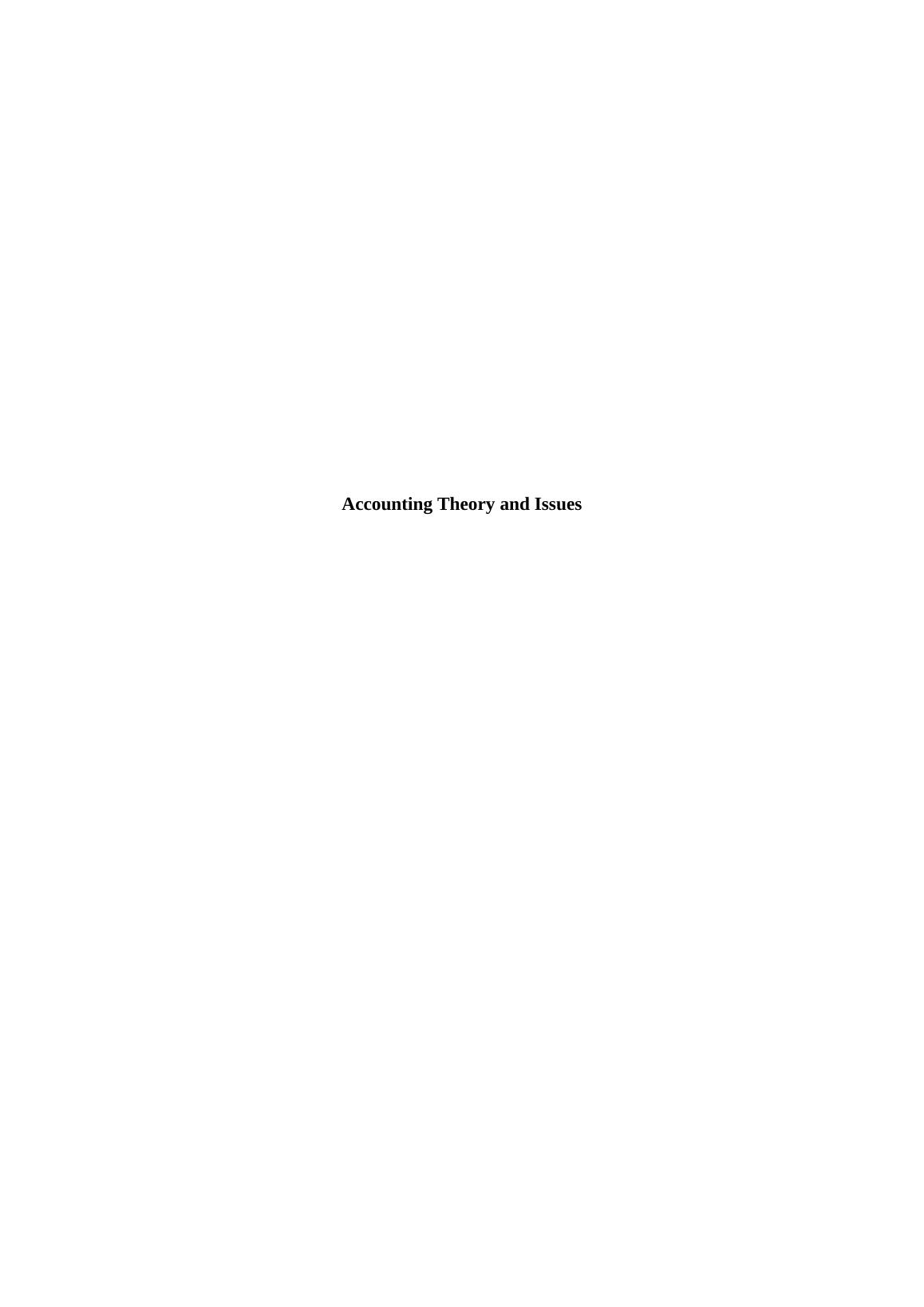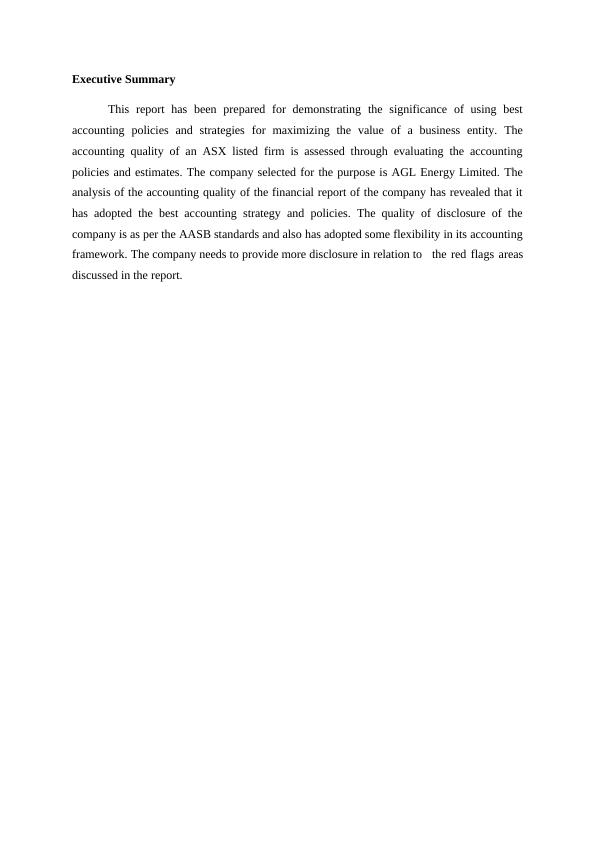Report on Accounting Theory and Issues
Added on 2020-04-07
13 Pages3612 Words31 Views
Accounting Theory and Issues

Executive SummaryThis report has been prepared for demonstrating the significance of using bestaccounting policies and strategies for maximizing the value of a business entity. Theaccounting quality of an ASX listed firm is assessed through evaluating the accountingpolicies and estimates. The company selected for the purpose is AGL Energy Limited. Theanalysis of the accounting quality of the financial report of the company has revealed that ithas adopted the best accounting strategy and policies. The quality of disclosure of thecompany is as per the AASB standards and also has adopted some flexibility in its accountingframework. The company needs to provide more disclosure in relation to the red flags areasdiscussed in the report.

IntroductionThe present report examines the accounting quality of a selected ASX listed companythrough evaluating its accounting policies and estimates. In this context, the report evaluatesthe accounting strategy of the selected business entity in the light of the various accountingtheories such as positive and normative theories of accounting. The accounting policies of abusiness entity play a critical role in achieving its corporate goals and objectives throughpromoting its long-term growth and development. The financial reports are developed inaccordance with the accounting policies that provide disclosure about the financial conditionof a firm to its stakeholders. Therefore, it is essential for a business entity to adopt the use ofstandard accounting policies that provides all the necessary information to the end-users andthrough adopting revealing accounting strategy. The accounting strategy is analyzed throughexamining the flexibility in the accounting policies and comparing them with the competitorpolicies (Mirza and Ankarath, 2012). Also, the report identifies the major issues of concern in the financial report of theselected company as red flags that require more disclosures. In addition to this, thecompliance of the company with the conceptual accounting framework principles is analyzedthrough examining the relevancy, reliability and understandability of financial informationprovided in the annual report. The influence of the political pressure on the accountingstandard-setting environment is also discussed in this report. The company selected for thepurpose is AGL Energy Limited, an Australian publicly-listed company involved in thedeveloping and retailing of electricity and gas both for residential and commercial purposes. Section 1: Identify Key Accounting PoliciesThe AGL Energy Limited is an ASX listed company and as such complies with theCorporations Act 2001 and accounting standards AASB for developing its financial reports(ASX and Media Releases, 2016). The company has valued its fixed assets of property, plantand equipment (PPE) at their cost through deducting the amount of net depreciation andimpairment losses. The cost of the assets includes the entire significant amount related to itspurchase and development. The income or loss realized from selling the fixed assets of PPEis attributed to the profit and loss account through calculating the difference between the saleproceeds and the carrying value of the asset. Thus, the accounting policy for measuring thevalue of the fixed assets is developed by the company as per the AASB 116 standard. Thedeprecation is calculated through the use of straight-line method. The intangible assets such

as goodwill are carried at their cost through deduction of any loss arising from theiramortization and impairment. The financial report is based on the principle of historical costwith the major exception of derivative financial instruments that are identified and measuredat their fair value (AGL Annual Report, 2016). Also, the company has adopted a corporate governance framework for effectivelymanaging the operational risks associated with the company operations. The governanceframework incorporates the use of energy hedging activities. The main objective of the riskgovernance framework is to hedge effectively the market price exposure of the companythrough operation of an integrated energy business. The hedging activity for minimizing therisk includes decrease in the hedging costs through incorporating the use of different financialinstruments such as weather derivatives for optimizing the risk and return (AGL AnnualReport, 2015). Section 2: Assessing the Accounting FlexibilityThe company operates its business activities in a highly competitive sector andtherefore the managers have incorporated some flexible accounting policies for valuemaximization. As such, the accounting of assets involving the expenses on exploration anddevelopment of oil and gas is not covered under the AASB 116 standard. The overallexpenses relating to exploration is recognized as asset and the accumulated expenditure istransferred to oil and gas assets. Also, the company has adopted a minimum shareholdingpolicy as per which the key management personnel of the company should hold specificnumber of shares in order to align the shareholder interests with the executives. There is nolegislative requirement on the company for adopting such policies but it has maintained thepolicy for improving the organizational commitment of its key management people (Jensen,2001). The accounting managers have also adopted the use of historical cost accountingmethod rather than using fair value accounting approach for measuring the financialinstruments value. The IASB has directed all the business entities complying with IFRSstandards to integrate the use of fair value accounting for measuring the value of assets andliabilities. However, the company is still adopting the use of historic cost accounting methodrather than using fair value accounting due to numerous problems associated with it such aschanging its tax structure value (AGL Annual Report, 2016). Thus, management as suchpossesses authority to change the accounting policies for improving the profitability position

End of preview
Want to access all the pages? Upload your documents or become a member.
Related Documents
Assignment Accounting Theory and Issueslg...
|14
|4230
|100
Accounting Policies and Estimates on PPElg...
|6
|848
|455
PPE Analysis of AGL Energy - Deskliblg...
|10
|1629
|408
Accounting Theory and Issues.lg...
|17
|3950
|58
Current Issues in Australian Accounting in AGL Energy Limitedlg...
|14
|3379
|324
Woolworths Limited Accounting Theorylg...
|15
|4498
|159
